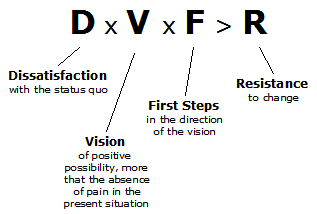Adrian Savage, over at
Slow Leadership, posts this good one on LifeHack.Org "
GTD? Try WNTGD Instead."
The essence?
- The GTD (Getting Things Done) phenomenon is yet another symptom of today’s short-term mentality and our obsession with activity (getting things done.)
- Getting Things Done is useful, of course for people with bulging schedules and huge to-do lists, who seek a better way to organize themselves.
- People would be better advised to turn their attention first to WNTGD: What Needs To Get Done.
BOTTOMLINE: In other words, the focus needs to change from getting things done (efficiency) to getting the right things done (effectiveness).
Translating this from individual efficiency (productivity) to organizational performance (execution), we begin to understand that execution means getting things done.
Strategy-driven execution means getting the right things done. There is a big difference. Among other things, a company's strategy describes how a company is going to survive and thrive over the long-run. Strategy-driven execution is all about the careful alignment of limited resources to the organization's strategy and to nothing else. Research shows that most businesses fail, not because of poor strategy, but because of poor execution of strategy.
Six Disciplines is the first complete strategy-driven execution program optimized for small businesses. It’s a systematic program for establishing six basic business disciplines related to strategy, planning, organization (of people, processes and technologies), connecting every employee’s daily actions, along with measurement and learning.
While larger businesses have spent millions of dollars on individual disciplines like strategy, performance management, etc., it has now become economically feasible for small businesses to benefit from the combination of these in a complete on-going business improvement “fitness” program. However, with any fitness program, the biggest hurdle is making it last.
To sustain these fundamental disciplines requires tight integration with day-to-day activities from every employee in the organization. To achieve maximum results, every employee must understand company strategy and how their daily work connects to it so they can self-manage to the strategy. In addition, it requires the accountability of an outside coach or advisor to keep organizations on track in learning and applying the disciplines. It also requires a community of like-minded organizations sharing best practices and accelerating learning.
The Internet and the convergence of efficiency and effectiveness are the enabling factors for the packaging of a next-generation program for breakthrough results in small business execution – strategy-driven execution.
Six Disciplines removes the barriers that prevent organizations from effectively executing their strategy, while creating a new culture of effective work habits and focused business processes.
Unlike other business improvement attempts like seminars, consultants or quick fixes, Six Disciplines make these new habits “stick” by providing practice tools to align individual performance, and on-going coaching to ensure organizational progress and accountability.




